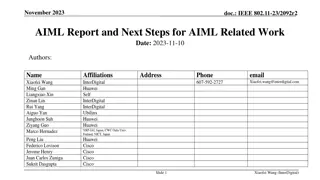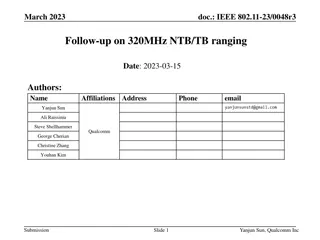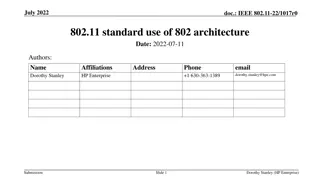IEEE 802.11-18/1986r1 NTB Ranging Flow Control and Power Save
The document from November 2018 by Qi Wang and Chris Hartman of Apple proposes parameters for controlling the timing of measurements in NTB ranging. It introduces MinTimeBetweenMeasurement and MaxTimeBetweenMeasurement for both rSTA and iSTA. The submission details the benefits of the proposed method, enabling power save at the rSTA and considering internal factors. The existing problem description addresses parameter setting rules for immediate rSTA-to-iSTA LMR and timing dependencies in measurement rounds.
Download Presentation

Please find below an Image/Link to download the presentation.
The content on the website is provided AS IS for your information and personal use only. It may not be sold, licensed, or shared on other websites without obtaining consent from the author. Download presentation by click this link. If you encounter any issues during the download, it is possible that the publisher has removed the file from their server.
E N D
Presentation Transcript
November, 2018 doc: IEEE 802.11-18/1986r1 NTB Ranging Flow Control and Power Save Date: 2018-11-11 Authors: Name Qi Wang Affiliations Address Apple, Inc. Phone email qi_wang2@apple.com chartman@apple.com Chris Hartman Apple, Inc. Submission Slide 1 Wang, Hartman, Apple
November, 2018 doc: IEEE 802.11-18/1986r1 Related CIDs This document relates to the following CIDs: 495, 496 Submission Slide 2 Wang, Hartman, Apple
November, 2018 doc: IEEE 802.11-18/1986r1 Proposal Overview For NTB ranging, we propose to use the following parameters to control the timing when the iSTA can initiate the next round of measurement. MinTimeBetweenMeasurement_rSTA (MinTBM_rSTA): rSTA s announcement of the minimal time interval between two consecutive measurements rounds MaxTimeBetweenMeasurement_rSTA(MaxTBM_rSTA): rSTA s announcement of the maximal time interval between two consecutive measurement rounds MinTimeBetweenMeasurement_iSTA (MinTBM_iSTA): iSTA s announcement of the minimal time interval between two consecutive measurement rounds MaxTimeBetweenMeasurement_iSTA(MaxTBM_iSTA): iSTA s announcement of the maximal time interval between two consecutive measurement rounds Submission Slide 3 Wang, Hartman, Apple
November, 2018 doc: IEEE 802.11-18/1986r1 Proposal Benefits The method in 802.11az_D0.5 uses the following parameters, all announced by the rSTA only, to control the NTB ranging timing: MinToAReady, defined as rSTA s timestamp processing time MaxToaAvailable, defined as rSTA s timestamp storage time MinTimeBetweenMeasurements Relative to the existing method, the proposal: Enables power save at the rSTA; Taking the iSTA s timestamp processing time and storage time and possibly other internal considerations into account Taking rSTA s other internal considerations, in addition to timestamp processing and storage time, into account. Submission Slide 4 Wang, Hartman, Apple
November, 2018 doc: IEEE 802.11-18/1986r1 Existing Problem Description iSTA rSTA SIFS UL? NDPA Parameter setting rules in [1] for immediate rSTA-to-iSTA LMR: MinToAReady = 0 MinTimeBetweenMeasurement <= MaxToAAvailable However, MaxToAAvailable is an ill defined concept for immediate rSTA-to-iSTA report The timing of the measurement round N does not depend on how long the rSTA keeps the results of round (N-1) t1_n UL? NDP t2_n SIFS DL? NDP t3_n SIFS t4_n LMR? (contain? t2_n,t3_n) Optional? LMR? MinTimeBetween Measurements MaxToaAvailable t1_n+1 UL? NDPA UL? NDP t2_n+1 Fig. 1 VHTz with immediate report in [1] Submission Slide 5 Wang, Hartman, Apple
November, 2018 Existing Problem Description cont d doc: IEEE 802.11-18/1986r1 rSTA rSTA SIFS UL? NDPA Parameter setting rules in [1] for delayed rSTA-to-iSTA LMR: MaxToAAvailable > MinToAReady > 0 MinTimeBetweenMeasurement = MinToAReady As a result, the rSTA must remain awake during the LMR Availability Ex: For MinToAReady = 25.5ms, MaxToAAvailable = 256ms, the rSTA needs to remain awake for (256 - 25.5 = 230.5)ms, t1_n UL? NDP t2_n SIFS DL? NDP t3_n SIFS t4_n LMR? (contain? t2_n,t3_n) Optional? LMR? MinTimeBetween Measurements MinToAReady MaxToaAvailable LMR? Availability t1_n+1 UL? NDPA UL? NDP t2_n+1 Fig. 2 VHTz with delayed report in [1] Submission Slide 6 Wang, Hartman, Apple
November, 2018 doc: IEEE 802.11-18/1986r1 Proposal Description During Negotiation, the iSTA announces MinTBM_iSTA MaxTBM_iSTA Both parameters are mandatory for delayed rSTA-to-iSTA LMR, optional for immediate rSTA-to-iSTA LMR In response, the rSTA announces: MinTBM_rSTA MaxTBM_rSTA If negotiation successful, Min/Max_TBM_rSTA are used for NTB ranging. When the rSTA cannot accommodate the Min/Max_TBM_iSTA, or the iSTA rejects Min/Max_TBM_rSTA, the negotiation fails; re-negotiation if desired. Submission Slide 7 Wang, Hartman, Apple
November, 2018 doc: IEEE 802.11-18/1986r1 Proposal Description cont d In selecting Min/Max_TBM_iSTA, the iSTA considers: iSTA s need to go to power save, iSTA s timestamp processing time and the timestamp storage time, for delayed rSTA-to-iSTA LMR, iSTA s other internal considerations. In selecting Min/Max_TBM_rSTA, the rSTA considers: rSTA s timestamp processing time and the timestamp storage time, rSTA s need to go to power save, rSTA s other internal considerations, MinTBM_iSTA, if any. MaxTBM_iSTA, if any. Submission Slide 8 Wang, Hartman, Apple
November, 2018 doc: IEEE 802.11-18/1986r1 Proposal Description Cont d The proposed method solve all cases listed below: No iSTA-to-rSTA LMR Immediate iSTA-to-rSTA LMR Delayed iSTA-to-rSTA LMR Immediate rSTA-to-iSTA LMR Case 1 Case 2 Case 3 Delayed rSTA-to-iSTA LMR Case 4 Case 5 Case 6 The proposal described in the subsequent slides assumes the same reference start point for the time intervals of Min/Max_TBM_rSTA/iSTA, If different start points are specified for these intervals, the rules for the relationships among these intervals need to be adjusted accordingly, to achieve the same effect. Submission Slide 9 Wang, Hartman, Apple
November, 2018 Solution Detail for Case 1 and Case 2 (1) doc: IEEE 802.11-18/1986r1 iSTA rSTA t1 Immediate iSTA-to- rSTA LMR Delayed iSTA-to-rSTA LMR No iSTA-to-rSTA LMR UL? NDPA SIFS Immediate rSTA-to- iSTA LMR Case 1 Case 2 Case 3 UL? NDP t2_n SIFS Delayed rSTA-to- iSTA LMR Case 4 Case 5 Case 6 DL? NDP t3_n SIFS LMR? (contain? t2_n,t3_n) t4_n SIFS Optional? LMR? (contain? t1_n,t4_n) The iSTA does not announce Min/Max_ TBM_iSTA. Proposed parameter setting rules for rSTA: MinTBM_rSTA < MaxTBM_rSTA Resulting behavior: The rSTA can go into power save after the completion of the measurement, and remain asleep for the duration of the MinTBM_rSTA time interval. The iSTA can go into power save after the completion of the measurement, and wakes up to initiate the next round of measurement taking into account of the parameters announced by the rSTA. Measurements_rSTA MinTimeBetween Power? save Power? save MaxTimeBetweenMeasureent_rSTA UL? NDPA t1_n+1 UL? NDP t2_n+1 Fig. 3 Proposal - case 1 and case 2 (without iSTA s parameter announcement) Submission Slide 10 Wang, Hartman, Apple
November, 2018 Solution Detail for Case 1 and Case 2 (2) doc: IEEE 802.11-18/1986r1 Immediate iSTA-to- rSTA LMR Delayed iSTA-to-rSTA LMR iSTA rSTA No iSTA-to-rSTA LMR t1 UL? NDPA SIFS Immediate rSTA-to- iSTA LMR Case 1 Case 2 Case 3 UL? NDP t2_n Delayed rSTA-to- iSTA LMR Case 4 Case 5 Case 6 SIFS t3_n DL? NDP SIFS LMR? (contain? t2_n,t3_n) t4_n Optionally, the iSTA announces Min/Max_TBM_iSTA. Proposed parameter setting rules for rSTA: MinTBM_rSTA >= MinTBM_iSTA MaxTBM_rSTA <= MaxTBM_iSTA Resulting behavior: The rSTA can go into power save after the completion of the measurement, and remain asleep for the duration of the MinTBM_rSTA time interval. The iSTA can go into power save after the completion of the measurement, and remain asleep for the duration of the MinTBM_rSTA time interval. SIFS Measurements_iSTA MinTimeBetween Measurements_rSTA MinTimeBetween Power? save MaxTimeBetweenMeasureent_iSTA Power? save MaxTimeBetweenMeasureent_rSTA UL? NDPA t1_n+1 UL? NDP t2_n+1 Fig. 4 Proposal - case 1 and case 2 (with iSTA s parameter announcement) Submission Slide 11 Wang, Hartman, Apple
November, 2018 doc: IEEE 802.11-18/1986r1 Solution Detail for Case 3 Immediate iSTA-to- rSTA LMR Delayed iSTA-to-rSTA LMR iSTA rSTA No iSTA-to-rSTA LMR t1 UL? NDPA SIFS Immediate rSTA-to- iSTA LMR Case 3 Case 1 Case 2 UL? NDP Delayed rSTA-to- iSTA LMR t2_n Case 4 Case 5 Case 6 SIFS t3_n DL? NDP SIFS LMR? (contain? t2_n,t3_n) t4_n Parameter setting rules for iSTA: MinTBM_iSTA >= processing time_iSTA MaxTBM_iSTA <= storage_time_iSTA Parameter setting rules for rSTA: MinTBM_rSTA >= MinTBM_iSTA MaxTBM_rSTA <= MaxTBM_iSTA Resulting behavior: The rSTA can go into power save after the completion of the measurement, and remain asleep for the duration of the MinTBM_rSTA time interval. The iSTA can go into power save after the timestamp processing and remain asleep until the end of the MinTBM_rSTA time interval SIFS Processing? Measurements_iSTA Measurements_rSTA MinTimeBetween MinTimeBetween MaxTimeBetweenMeasureent_iSTA time Power? save MaxTimeBetweenMeasureent_rSTA Power? save LMR? Availability UL? NDPA t1_n+1 UL? NDP t2_n+1 Fig. 5 Proposal - case 3 Submission Slide 12 Wang, Hartman, Apple
November, 2018 Solution Detail for Case 4 and Case 5 (1) doc: IEEE 802.11-18/1986r1 rSTA iSTA Immediate iSTA-to- rSTA LMR Delayed iSTA-to-rSTA LMR UL? NDPA No iSTA-to-rSTA LMR SIFS t1_n Immediate rSTA-to- iSTA LMR UL? NDP Case 1 Case 2 Case 3 t2_n Delayed rSTA-to- iSTA LMR SIFS Case 4 Case 5 Case 6 DL? NDP t3_n SIFS t4_n LMR? (contain? t2_n-1,t3_n-1) SIFS The iSTA does not announce Min/Max_TBM_iSTA Parameter setting rules for rSTA: MinTBM_rSTA >= processing_time_rSTA MaxTBM_rSTA <= stroage_time_rSTA MinTBM_rSTA < MaxTBM_rSTA Resulting behavior: The rSTA can go into power save after the completion of the measurement, and remain asleep until the end of the MinTBM_rSTA time interval. The iSTA can go into power save after the completion of the measurement, and wakes up to initiate the next round of measurement taking into account of the parameters announced by the rSTA. Optional? LMR? (contain? t1_n,t4_n) Processing? Measurements_rSTA MinTimeBetween time MaxTimeBetweenMeasurement_rSTA Power? save Power? save LMR? Availability UL? NDPA t1_n+1 UL? NDP t2_n+1 Fig. 6 Proposal - case 4 and case 5 (without iSTA s parameter announcement) Submission Slide 13 Wang, Hartman, Apple
November, 2018 Solution Detail for Case 4 and Case 5 (2) doc: IEEE 802.11-18/1986r1 rSTA iSTA Immediate iSTA-to- rSTA LMR Delayed iSTA-to-rSTA LMR No iSTA-to-rSTA LMR UL? NDPA SIFS t1_n Immediate rSTA-to- iSTA LMR Case 1 Case 2 Case 3 UL? NDP t2_n Delayed rSTA-to- iSTA LMR Case 4 Case 5 SIFS Case 6 DL? NDP t3_n SIFS t4_n LMR? (contain? t2_n-1,t3_n-1) SIFS Optionally, iSTA announces Min/Max_TBM_iSTA Proposed parameter setting rules for rSTA: MinTBM_rSTA > = processing_rSTA MinTBM_rSTA >= MinTBM_iSTA MinTBM_rSTA <= MaxTBM_iSTA MaxTBM_rSTA <= storage_time_rSTA MaxTBM_rSTA >= MinTBM_iSTA MaxTBM_rSTA <= MaxTBM_iSTA Resulting behavior: The rSTA can go into power save after the completion of the measurement, and remain asleep for the duration of the MinTBM_rSTA time interval. The iSTA can go into power save after the completion of the measurement, remain asleep for the duration of the MinTBM_rSTA time interval, then wakes up to initiate the next round of measurement. Optional? LMR? (contain? t1_n,t4_n) Measurements_rSTA Processing? MinTimeBetween Measurements_rSTA MaxTimeBetweenMeasureent_iSTA MinTimeBetween Power? save time MaxTimeBetweenMeasurement_rSTA Power? LMR? Availability save UL? NDPA t1_n+1 UL? NDP t2_n+1 Fig. 7 Proposal - case 4 and case 5 (with iSTA s parameter announcement) Submission Slide 14 Wang, Hartman, Apple
November, 2018 doc: IEEE 802.11-18/1986r1 Solution Detail for Case 6 rSTA iSTA UL? NDPA SIFS Immediate iSTA-to- rSTA LMR Delayed iSTA-to-rSTA LMR t1_n No iSTA-to-rSTA LMR UL? NDP t2_n Immediate rSTA-to- iSTA LMR Case 1 Case 2 Case 3 SIFS DL? NDP t3_n Delayed rSTA-to- iSTA LMR SIFS Case 6 Case 4 Case 5 t4_n LMR? (contain? t2_n-1,t3_n-1) Parameter setting rules for iSTA: MinTBM_iSTA >= processing_time_iSTA MaxTBM_iSTA <= storage_time_iSTA Parameter setting rules for rSTA: MinTBM_rSTA > = processing_time_rSTA MinTBM_rSTA > = MinTBM_iSTA MinTBM_rSTA <= MaxTBM_iSTA MaxTBM_rSTA <= Storage_time_rSTA MaxTBM_rSTA >= MinTBM_iSTA MaxTBM_rSTA <= MaxTBM_iSTA Resulting behavior: The rSTA can go into power save after timestamp processing and remain asleep until the end of the MinTBM_rSTA time interval. The iSTA can go into power rave after timestamp processing and remain asleep until the end of the MinTBM_rSTA time interval. SIFS Optional? LMR? (contain? t1_n,t4_n) Measurements_rSTA Processing? Processing? MinTimeBetween Measurements_rSTA MinTimeBetween MaxTimeBetweenMeasureent_iSTA time time MaxTimeBetweenMeasurement_rSTA Power? save Power? LMR? Availability save LMR? Availability UL? NDPA t1_n+1 UL? NDP t2_n+1 Fig. 8 Proposal - case 6 Submission Slide 15 Wang, Hartman, Apple
November, 2018 doc: IEEE 802.11-18/1986r1 Summary We have proposed a flow control mechanism for NTB ranging so that both iSTA and rSTA can go to power save. The proposed solution addresses all combinations of immedate/delayed rSTA-to-iSTA and/or iSTA-to-rSTA LMR. Submission Slide 16 Wang, Hartman, Apple
November, 2018 doc: IEEE 802.11-18/1986r1 Straw Poll Do you support to the mechanism described in this document for NTB mode? Results: Yes: No: Abstain: Submission Slide 17 Wang, Hartman, Apple
November, 2018 doc: IEEE 802.11-18/1986r1 References [1] IEEE Draft P802.11az_D0.5 - Draft Standard for Information Technology - Telecommunications and Information Exchange Between Systems Local and Metropolitan Area Networks - Specific Requirements Part 11: Wireless LAN Medium Access Control (MAC) and Physical Layer (PHY) Specifications - Amendment 8: Enhancements for Positioning Submission Slide 18 Wang, Hartman, Apple























